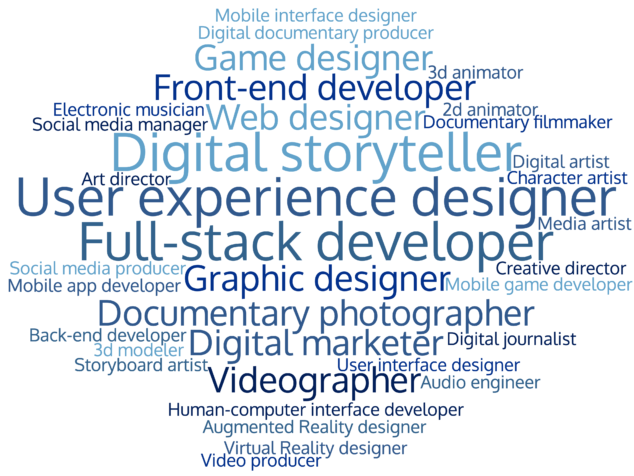New Media Careers
Where will I work?
The first jobs New Media graduates get often lie at either end of the spectrum between art and computer science. Salaries tend to depend on which end of this spectrum you’re on: the 2018 median salary of a new media designer was $72,000, while that of a mobile developer in 2019 was $170,000.
Whatever their initial specialty, as their careers progress many New Media alumni end up working with interdisciplinary teams, because their undergraduate experience taught them how the varied facets of a complex digital project come together. Some of the teams our alumni work with are small, like the dozen people refining The New York Times’ iPhone app. Others oversee vast organizations, like the hundreds of employees responsible for the BBC’s digital content. Still other alumni work freelance for small outfits or behemoths like Marvel Entertainment.
What will I do?
It’s hard to think of a field that has not been transformed by the digital revolution, which paradoxically means it can be daunting to decide among the bewildering variety of career choices. As first years in college, many undergraduates don’t know what they want to pursue, and many others don’t realize all the careers available to them. You may have heard of job titles like Graphic Designer or Game Developer, but not of Creative Director or Front-End Developer.
Some graduates travel to distant lands to pursue their dreams, from Korea and Japan to London and San Francisco. Others choose to stay closer to home or return when they’re older. One co-founded a startup a few blocks from campus that now has clients in all 50 states and handles millions of dollars in transactions each year.


How should I pick courses?
For those looking for a clear-cut path, we cluster some courses into “career paths,” subjects that complement each other and teach the skills for a specific profession such as user experience design, digital storytelling, or app development. You are not required to follow one of these concentrations, but these advising guidelines can help you pick classes in- and outside the major that prepare you for specific vocations. That said, we also encourage students to think outside the box, which is why we also have alumni in healthcare designing innovative medical instruments and in journalism provide new networked models for today’s newspapers.
How will I attract employers?
Given the wide range of new media expertise, we’ve created tools to help employers understand the specific skills our students have acquired. One of these is the Just-in-Time Learning badges, which can be displayed on a student’s portfolio or website. These offer verifiable microcredentials for fine-grained skills, from how to edit a digital photograph to how to use a bandsaw. Employers can click on each badge and see what was required to learn to earn that microcredential.


